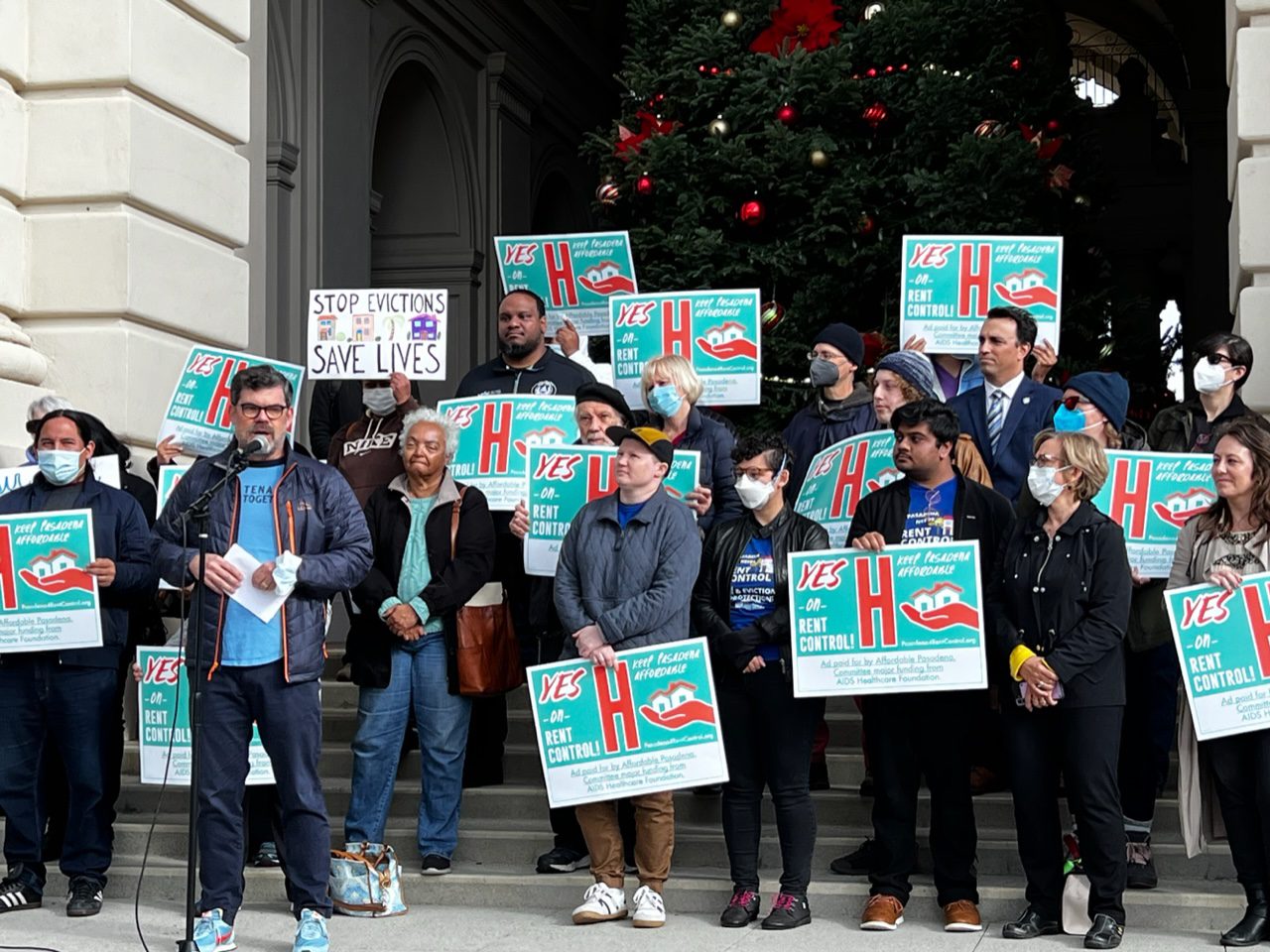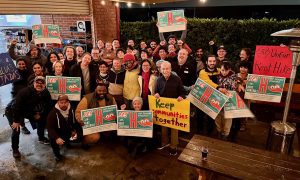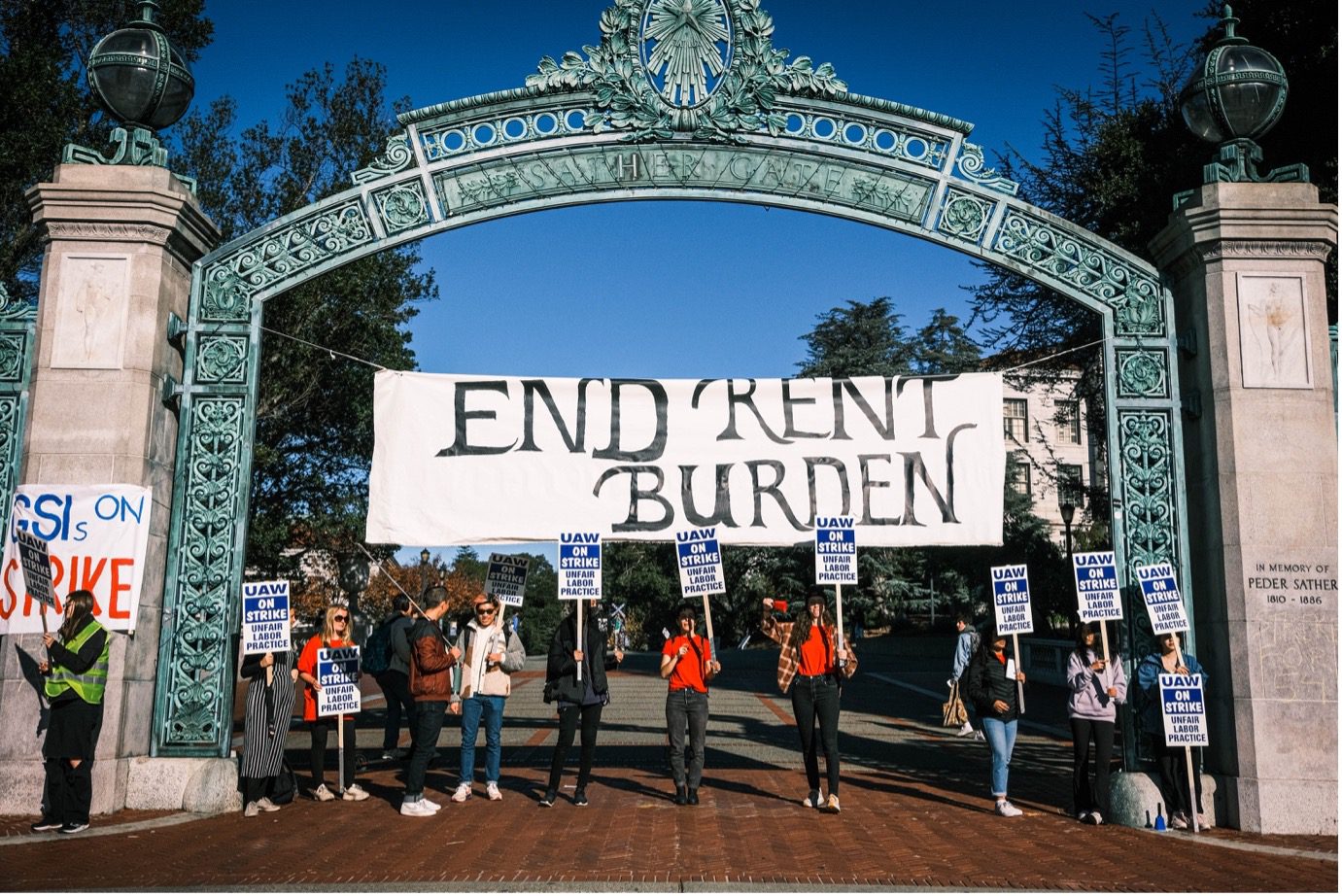This article is part of the Under the Lens series

Ryan Bell, at microphone, addresses a rally on Dec. 12, 2022, officially announcing victory on Measure H. Photo by Alejandro Rivas
The last year and a half has seen significant progress for renters in Southern California. Though there is still a long way to go before our laws reflect the fact that housing is a human right, cities that have never had even the most rudimentary protections are seeing rent control and related tenant protections passed, thanks to the power of organizing.
The city of Santa Ana passed rent control and just cause eviction ordinances in October 2021—the first city in Orange County history to have these protections. It subsequently passed an ordinance establishing a rental housing board.
The city of Pomona in Los Angeles County passed rent control and just cause ordinances last summer after more than five years of community organizing and pressure campaigns.
Bell Gardens, a city of about 40,000 residents in east Los Angeles County, passed rent control and just cause protections in September 2022. Despite the city’s population being 79 percent renter households, the women of Union de Vecinas de Bell Gardens had to fight for nearly two years before getting three of the five city council members to approve these measures.
Building on this series of wins, the most recent victory for tenants happened in November 2022 in Pasadena, where 53.8 percent of the city’s nearly 90,000 voters passed Measure H—a comprehensive tenant protection charter amendment placed on the ballot by the Pasadena Tenants Union and a strong coalition of supportive organizations and individuals.
What It Does and Why It Was Needed
Pasadena is city of renters, of which I am one. According to recent census data, at least 58 percent of households rent their homes and rates of rent burden are similar to other large metropolitan areas in the United States—high. In 2018, 54 percent of Pasadena’s renter households were paying more than 30 percent of their income toward rent and 31 percent were paying over 50 percent. That rent burden is much more likely to fall on Black and brown families. Seventy percent of African American households and 68 percent of Hispanic/Latinx households in Pasadena rent their homes.
Under the new rent control and just cause law—now Article XVIII of the Pasadena City Charter—tenants are entitled to an impressive array of new protections as of December 2022.
Rents for most tenants may now only be raised once per year and by no more than 75 percent of the Consumer Price Index (CPI) for qualifying units. (California’s Costa-Hawkins Rental Housing Act exempts single family homes, condos, and units built in 1995 or after from local rent control regulations.) Landlords need a just cause to evict a tenant from their unit, such as failure to pay rent or another violation of the lease. While there are still several no-fault just causes (for example, the owner or their family is moving into the unit), substantial renovation is no longer a just cause in Pasadena. Landlords must pay to relocate tenants during the renovation and offer the unit back to the original tenant at the rent they had been paying.
If landlords harass tenants for organizing a tenant association, the tenants have legal recourse to fight back. Landlords can be prosecuted for failure to abide by Article XVIII of the city charter.
The charter amendment also establishes a rental registry and an independent rental housing board which must have a tenant majority.
Early Attempts at Rent Control and Just Cause Eviction
As with most grassroots campaigns, the path to victory was not straight. Several residents recall that the first efforts for rent control began over 20 years ago.
“With the housing crisis being so extreme today, it’s easy to forget that we were in a housing crisis back then,” recalls Bert Newton, a housing justice activist in Pasadena for over 25 years. “People on our steering committee were losing their homes.”
These early efforts involved lobbying the city’s seven council members, presenting the rent burden faced by the city’s residents, and asking for rent control and eviction protections. These pleas were universally ignored. There was not a single supportive councilmember in those early days, according to those who took part in those struggles.
For years there was no answer to the recalcitrance of city leaders.
In late 2016, two tenants, inspired by the newly formed Los Angeles Tenants Union, set about forming the Pasadena Tenants Union (PTU). At that time tenants could be evicted with 60 days’ notice for any reason. I was one such tenant. With no warning, in the summer of 2017, my landlord gave me a 60-day notice to vacate my apartment. Having lived in a rent controlled apartment in Los Angeles from 2005 to 2013, I assumed this was illegal. That’s when I discovered that there were no tenant protections in Pasadena. If a landlord wanted to displace any tenant, the only requirement was 60 days’ notice. My research led me to PTU. So many of the initial PTU members were displaced in those early days that it was nearly impossible to build a consistent base for our new union. In that context, members decided that the first major campaign should be for rent control and just cause.
Still without a single elected official on our side, we opted to run a ballot initiative campaign. With help from Public Council attorneys, we wrote our own ordinance and began collecting signatures with the hope of qualifying for the 2018 ballot. When it was clear that we were going to fall several thousand signatures short, the tenants union was forced to regroup.
In 2019, PTU established the Pasadena Tenant Justice Coalition (PTJC) to draw together a broad group of local and regional organizations to support the next effort. Answering the call were the ACLU of Southern California, the League of Women Voters Pasadena Area, the Democratic Socialists of America–Los Angeles, and Socialists of Caltech, all of whom joined with the Pasadena Tenants Union to form the new coalition and share the work.
The coalition decided to pursue a charter amendment rather than an ordinance and the policy committee set about reworking the language of the measure. This decision made the next effort more difficult. To qualify a charter amendment for the ballot in Pasadena requires 15 percent of the registered voters to sign a petition as opposed to the 10 percent needed for an ordinance. The coalition made this decision, in spite of the difficulty, because that very difficulty would also make an amendment hard to reverse once secured, placing these protections farther out of reach of the mayor and city council members, who we felt would immediately seek to weaken or even repeal them.
Changing Conditions
In March 2020 the COVID-19 pandemic interrupted the coalition’s ability to safely collect signatures as the entire nation came under stay-at-home orders. We eventually set our sights on the November 2022 General Election, still aiming for a charter amendment. Signature gathering began in October 2021. Over 300 volunteers exercised extreme caution during repeated waves of COVID variants throughout the fall and into the winter of 2022, wearing KN-95 masks as they stood in front of grocery stores and other public places in extreme heat, and then rain and cold, every weekend for six months.
[RELATED ARTICLE: How Portland, Maine, Passed Rent Control]
The pandemic also pulled back the curtain on widespread housing insecurity, dangerous living conditions, and endemic landlord harassment and abuse. Individuals and families who had never understood themselves to be housing insecure suddenly saw their income disappear and with it, the ability to pay their rent. A rapidly changing regulatory landscape also created confusion and anxiety. While most tenants had strong defenses against eviction, landlords continued to issue invalid demands to pay and eviction notices. Hundreds of tenants self-evicted, others froze in fear. “The tenants union was inundated with calls and emails,” recalls coalition member organizer Jane Panangaden. “No one knew what was going on as the laws kept changing at the local, state, county, and federal levels all at once.”
During the early days of the COVID-19 pandemic, Pasadena also gained a champion for tenant protections on the City Council. In March of 2020, Councilmember Victor Gordo was elected mayor of Pasadena, leaving a vacancy in District 5. In accordance with city charter rules regarding vacancies, Jess Rivas was appointed to the District 5 seat. She ran and officially won her seat in June 2022, and shortly afterward she endorsed and actively campaigned for Measure H, as the rent control charter amendment came to be known.
The Winning Campaign
After another slow start to signature gathering, PTJC teamed up with the campaign consultants at Red Bridge Strategies, Jen Snyder and Avery Yu, in September 2021. Snyder and Yu had successfully managed several ballot initiative campaigns in San Francisco, as well as Dean Preston’s successful campaign for San Francisco supervisor. Their involvement in the Pasadena Measure H campaign brought technical skill and experience as well as the focus and discipline needed to win.
The campaign ultimately gathered just over 20,000 signatures in the process of qualifying for the ballot. Our internal validation process determined that we had 15,352 valid signatures which we submitted to the Pasadena City Clerk at the end of March 2022. After the Los Angeles County Clerk’s office conducted their validation process, the campaign had 15,101 valid signatures, 13 percent more than the required 13,366 signatures.
As soon as the charter amendment qualified for the ballot the team went into campaign mode, starting with having signs printed and posting them in the windows of supportive local businesses.
For six months, hundreds of volunteers fanned out throughout the city, most often on weekends, knocking on doors, informing voters about Measure H, answering questions, and securing commitments to vote yes on Measure H.
The campaign knocked on over 42,000 doors, made calls to more than 29,000 people, and placed over 150 yard signs around the city. Community members and campaign leaders wrote at least a dozen op-eds in local papers explaining Measure H and countering misinformation and distortions from current and former elected officials, Realtors, landlords, and the Chamber of Commerce. The campaign also raised $357,642 from over 350 individual donors, as well as several foundations and one labor union, SEIU Local 2015.
With support from our consultants, the campaign was able send eight pieces of mail, nearly matching the number of mail pieces sent by the landlord and Realtor opposition, and advancing a positive message of community solidarity and support for low- and middle-income tenants.
Overcoming the Opposition
The “No on Measure H” campaign was led by the California Apartment Association (CAA), with strong support from the National Association of Realtors and the California Association of Realtors. Their local proxies included the Pasadena Foothills Association of Realtors, the Pasadena Chamber of Commerce, and a variety of current and former elected officials, including Mayor Victor Gordo, who wrote an op-ed in Pasadena Now condemning rent control as a failed policy. The previous mayor of Pasadena, Terry Tornek, also came out strongly against Measure H, penning an op-ed and signing the opposition argument in the ballot handbook.
The No on Measure H campaign leaders also marshaled their supporters to spread misinformation on Facebook and the Nextdoor app, but they had no visible field campaign. They also had yard signs, but since they lacked strong support in the community, few homeowners were interested in putting a No on H sign in their yard. Instead, they resorted to placing them in illegal locations like roadway medians and parkways, from which they were frequently removed.
The No on Measure H messaging will be familiar to anyone who has worked on rent control campaigns anywhere in the country. It claimed simplistically that “rent control doesn’t work” without addressing for who or for what. It said rent control kills new development, which it doesn’t. Especially under Costa-Hawkins there isn’t even a potential disincentive. Not to mention, local homeowners—often the same people who oppose rent control—are already blocking new development of apartments through their political advocacy.
Opponents said that rent control would make rents go up for tenants, and also that it would cripple landlords’ ability to make essential repairs. Missing from that argument, of course, is the fact that landlords weren’t making essential repairs before rent control and that their arguments are mutually exclusive—does rent control make rent go up or reduce landlord revenue? It can’t be both.
They also argued that if rent control passed, landlords would simply sell their buildings to large corporations who would be even worse actors or take their units off the market altogether. “Every argument against rent control is nothing more than a threat to make tenant’s lives even worse,” said one tenant who volunteered to pass Measure H. Voters correctly discerned that the real estate industry’s arguments were projecting their own behaviors and choices onto a policy that simply limits the amount of abuse landlords are allowed to heap on their tenants. It is not rent control that causes apartment units to deteriorate from disrepair and neglect. It is landlords who make those choices, chasing maximum profits. No one is forcing landlords to neglect their investment properties or raise the rent beyond what is needed for a fair return in the long-term. The logic of profit guides them to this neglect and abuse.
In the absence of a convincing message or base of support, the opposition threw in $436,515—including $100,000 from the National Association of Realtors alone—to send mail designed to scare people into voting no. In the past, the CAA could count on voters to be fearful enough to vote no after being subjected to scare tactics. That’s what happened in Sacramento and Burbank in 2020.

Supporters of Measure H gathered at Cerveceria del Pueblo on election night as initial election returns came in. Photo by Brooke Peterson-Bell
This time it wasn’t enough.
Measure H passed with 53.8 percent of the voters approving. Detailed election returns revealed that Measure H also passed in 6 of 7 council districts, a feat few people thought was possible. In renter-dense districts, typically plagued by low voter participation, Measure H passed by as much as 69 percent and appears to have mobilized new and infrequent voters, in spite of the fact that it was a midterm election.
After decades of being ignored by our elected officials, tenants took the fight directly to the voters and won! Pasadena is the first city in California south of the Bay Area to pass rent control by ballot initiative. But this is a victory for more than just Pasadena. We are changing the horizon of the possible well beyond our city. Tenant unions from Santa Barbara to San Bernardino are dreaming big and demanding that their elected officials pass rent control and permanent eviction protections. Together we are proving the old organizing adage: when we fight, we win!






Comments